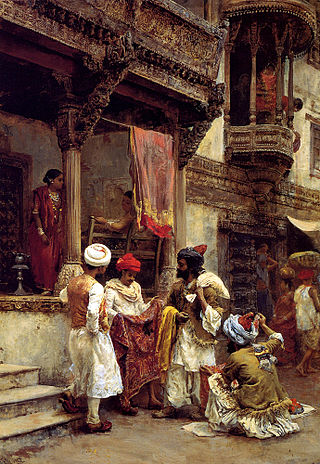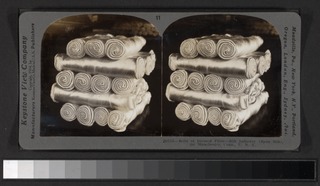Related Research Articles

Textile is an umbrella term that includes various fiber-based materials, including fibers, yarns, filaments, threads, different fabric types, etc. At first, the word "textiles" only referred to woven fabrics. However, weaving is not the only manufacturing method, and many other methods were later developed to form textile structures based on their intended use. Knitting and non-woven are other popular types of fabric manufacturing. In the contemporary world, textiles satisfy the material needs for versatile applications, from simple daily clothing to bulletproof jackets, spacesuits, and doctor's gowns.

Dyeing is the application of dyes or pigments on textile materials such as fibers, yarns, and fabrics with the goal of achieving color with desired color fastness. Dyeing is normally done in a special solution containing dyes and particular chemical material. Dye molecules are fixed to the fiber by absorption, diffusion, or bonding with temperature and time being key controlling factors. The bond between the dye molecule and fiber may be strong or weak, depending on the dye used. Dyeing and printing are different applications; in printing, color is applied to a localized area with desired patterns. In dyeing, it is applied to the entire textile.
A staple fiber is a textile fiber of discrete length. The opposite is a filament fiber, which comes in continuous lengths. Staple length is a characteristic fiber length of a sample of staple fibers. It is an essential criterion in yarn spinning, and aids in cohesion and twisting. Compared to synthetic fibers, natural fibers tend to have different and shorter lengths. The quality of natural fibers like cotton is categorized into staple length such as short, medium, long staple, and extra-long. Gossypium barbadense, one of several cotton species, produces extra-long staple fibers. The staple fibers may be obtained from natural and synthetic sources. In the case of synthetics and blends, the filament yarns are cut to a predetermined length.
Wet Processing Engineering is one of the major streams in Textile Engineering or Textile manufacturing which refers to the engineering of textile chemical processes and associated applied science. The other three streams in textile engineering are yarn engineering, fabric engineering, and apparel engineering. The processes of this stream are involved or carried out in an aqueous stage. Hence, it is called a wet process which usually covers pre-treatment, dyeing, printing, and finishing.

Mashru is a woven cloth that is a blend of silk and cotton. It was historically a hand-woven satin silk fabric variety found in the Indian subcontinent, and its proper use is described in the 16th-century Ain-i-Akbari.

Greige goods are loom state woven fabrics, or unprocessed knitted fabrics. Greige goods undergo many subsequent processes, for instance, dyeing, printing, bleaching, and finishing, prior to further converting to finished goods such as clothing, or other textile products. "Grey fabrics" is another term to refer to unfinished woven or knitted fabrics.

Marquisette is a lightweight, sheer fabric that has a structure similar to a mosquito net.
Ailesham cloth was a fine linen cloth made in England during Middle Ages.
Agra gauze was a thin, translucent fabric with a loose open weave. The material was made of silk with a plain weave. Agra gauze was also known as Agre. The fabric is named after the Agra city. The cloth was used in trimmings.
Anidex is one of the elastomeric synthetic fibers. It is made from an artificial linear polymer consisting of at least 50% by mass of one or more monohydric alcohol esters.

Brocatelle is a silk-rich fabric with heavy brocade designs. The material is characterized by satin effects standing out in relief in the warp against a flat ground. It is produced with jacquard weave by using silk, rayon, cotton, or many synthetic yarns.
A Rampur chaddar was a kind of handspun woolen shawl that originated in the town of Rampur in Himachal Pradesh, India, during the 19th century. They were later manufactured in cities of the Punjab such as Ludhiana and Amritsar, and also imported from outside India.
Albatross is a lightweight, soft material with a napped and slightly creped surface. It has the worsted appearance.
Diaper is a damask cloth with small geometrical patterns such as bird's eye or diamond shapes. Terms such as “bird’s eye” or “pheasant’s eye” refer to the size of the diamond in the design. Diaper has been used as a tablecloth.
Barré is an unintentional repetitive horizontal pattern in fabrics that is generally undesirable and considered as a defect. It appears as a lateral stripe pattern. Barré occurs for many reasons associated with the manufacturing of textile ensembles like fiber, yarn, fabric manufacturing, weaving or knitting, or finishing faults.
Cottonade was a coarse and heavy cotton cloth, usually yarn dyed. Multiple formations were available, including plain, twill, and serge. It was a kind of woolen imitation, and the strong variants were used for men's trousers. Twill structured blue-and-white striped men's workwear with hickory cloth-like appearance was used. Cottonade was initially used for less-expensive men's clothing, it was eventually supplanted by superior materials such as "cassimeres" (kerseymere), which became fashionable.
Radzimir was a kind of silk serge, and It had been dyed black. Radzimir was an elegant silk material created particularly for mourning purposes. Radzimir was a fine, sturdy, and lustrous structure made of plain weave and ribbed weft.The name of the fabric is related to the French "Ras de Saint-Maur", which was a term used to designate a silk dress fabric from the 18th century. The fabric was entirely made of silk, silk, and fteuret, or wool warp and silk in filling.
Compaction (compacting) is a finishing process used to minimize shrinking in textiles. Textile products that are loosely woven or knitted shrink more, whereas tightly knitted and woven products are more stable. The structure of knitted fabrics is competitively loose and flexible. Compaction, like sanforization for woven fabric, is intended to reduce shrinkage in tube and open width Knitted textiles.
Balbriggan was a type of hosiery fabric. It was a finely knitted cotton cloth predominantly used for men's underwear. Originally it was made of unbleached Egyptian cotton that imparts natural coloured tones such as dark cream and tan. The fabric's name refers to the town in which it was manufactured, Balbriggan in Ireland. The town prospered as a result of the fabric's production.
Lisle was a type of finish that was applied to obtain smooth and even yarns, largely employed for goods intended for underwear and hosiery. Yarns made with long-staple fibers such as Egyptian cotton were passed repeatedly and swiftly through gas flames. The action removes the fuzzy and protruding fibers. The finish adds smoothness, gloss, and evenness to the yarn. Most often, yarn done with a lisle finish was referred to as " Lisle yarn." or "Lisle thread." These were plied, high-twisted, gassed combed yarns of long-staple cotton.
References
- ↑ ''This paper cloth has been extensively used in Germany during the war for every conceivable purpose and has been successful in varying ... in the wear or wash, but it is not believed they can ever complete with cottu : 1, wool, flax, or silk for ordinary articles of clothing . ... A number of patents have been granted in different parts of the world for spinning paper into yarn'' Paper: A Weekly Technical Journal for Paper and Pulp Mills 1919 page150
- ↑ ''The manufacture of paper yarns and textile fabrics therefrom underent a tremendous development in Germany and Austria during the ' cent World War . The paper used for spinning paper yarns is almost ntirely made from wood - pulp .'' The Textile Fibers, Their Physical, Microscopical Joseph Merritt Matthews · 1924 Page847
- 1 2 3 Fairchild's dictionary of textiles. New York: Fairchild Publications. 1959. pp. 320, 400, 409, 509.
- ↑ MATHEWS, KOLANJIKOMBIL (2017). Encyclopaedic Dictionary of Textile Terms: Four Volume Set. Woodhead Publishing India PVT. Limited. p. 1044. ISBN 978-93-85059-66-7.
- ↑ Carter, Ernest Frank (1974). Dictionary of inventions and discoveries. London: Frederick Muller. p. 129. ISBN 978-0-8448-0867-3.
- ↑ ''XYLOLIN, a substance made of wood and fit for exclusive use in weaving, has been patented by Emit Claviez (Saxony, Germany). Xylolin is non-shrinkable and impervious to water.'' p.21https://archive.org/details/logginglumbering00scheuoft/page/160/mode/2up?q=Xylolin
- ↑ MATHEWS, KOLANJIKOMBIL (2017). Encyclopaedic Dictionary of Textile Terms: Four Volume Set. Woodhead Publishing India PVT. Limited. p. 1587. ISBN 978-93-85059-66-7.
- ↑ ''GERMAN PAPER CLOTHING is not so plentiful, and the standards of dress not so high as in this country, exports of ... of the competition which may have to of the World with Their Paper Substitutes for Near Cloth- be overcome, because of the ... Norwegian Paper Clothing While many stories have been written since the beginning of the European war relative to the ... Even then the to be making increasing use of paper yarns . price will have to be very low, about $ 1 per suit to attract'' https://www.google.co.in/books/edition/Paper_Trade_Journal/dAxQAQAAIAAJ?hl=en&gbpv=1&bsq=Page48
- ↑ The Economic World. Chronicle Publishing Company. 1918. p. 319.
- ↑ The Paper-maker and British Paper Trade Journal. 1921. p. 236.